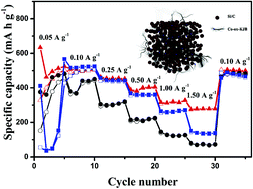Enhanced rate performance of lithium-ion battery anodes using a cobalt-incorporated carbon conductive agent†
Abstract
Lithium-ion batteries with enhanced rate performance are of crucial importance for practical applications. Extensive studies on the structural design and surface modification of electrode materials with the aim of improving the rate performance have been reported. Here we describe a new concept to enhance the rate capability by incorporating a tiny amount of metal species into the electron conductive agent. We show that the Si/C composite anode exhibits increased capabilities at high current densities when oxidized Ketjen black (KJB) with incorporated cobalt (Co-ox-KJB) is used as the electron conductive agent. Compared with the pristine KJB, the reversible capacities of the Si/C electrode with the Co-ox-KJB are increased by 180% on average at 1.50 A g−1 (279 mA h g−1vs. 73 mA h g−1, respectively). A synergistic contribution from enhanced electron conductivity by Co incorporation, improved affinity towards the electrolyte and an enhanced desolvation process by surface functional groups is responsible for the improved electrochemical performance. This approach is applicable for super P-based electron conductive agents as well.



 Please wait while we load your content...
Please wait while we load your content...